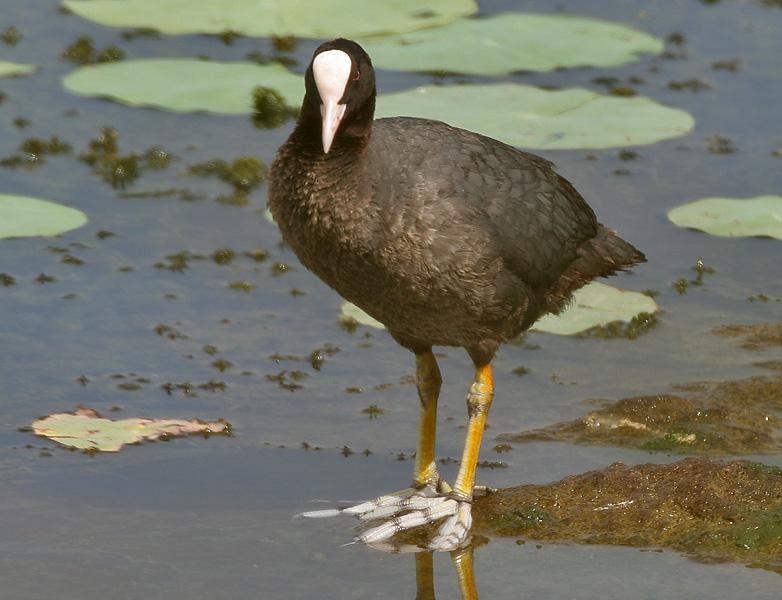
Eurasian coot(Fulica atra)
Phylum —chordata
Class — aves
Order — gruiformes
Family — rallidae
Genus –fulica
Appearance
The Eurasian coot is 36–38 cm (14–15 in) in length with a wing-span of 70–80 cm (28–31 in); males weigh around 890 g (31 oz) and females 750 g (26 oz). It largely black except for the white bill and frontal shield. As a swimming species, the coot has partial webbing on its long strong toes. The sexes are similar in appearance.
The juvenile is paler than the adult, has a whitish breast, and lacks the facial shield; the adult black plumage develops when about 3–4 months old, but the white shield is only fully developed at about one year old.
Habitat
The coot breeds across much of the Old World on freshwater lakes and ponds. It occurs and breeds in Europe, Asia, Australia, and Africa. It is resident in the milder parts of its range, but migrates further south and west from much of Asia in winter as the waters freeze.
Behavior
The Eurasian coot is much less secretive than most of the Rallidae family, and can be seen swimming on open water or walking across waterside grasslands.
It is an aggressive species, and strongly territorial during the breeding season, and both parents are involved in territorial defense. During the non-breeding season they may form large flocks, possibly related to predator avoidance.
When fighting other waterbirds (especially other coots), the coot attacks by charging its opponent and striking them with its long legs.
Diet
The coot is an omnivore, and will take a variety of small live prey including the eggs of other water birds, as well as algae, vegetation, seeds and fruit.
Reproduction
The nest is a bulky structure that is placed on the bottom in shallow water. It is constructed of plant stems and leaves with a lining of finer material. Normally concealed in vegetation the nest can sometimes be placed in the open. It is built by both sexes with the male collecting most of the material which is incorporated by the female. The eggs are laid at daily intervals. The clutch contains between six and ten smooth and slightly glossy buff colored eggs that are covered with black or dark brown speckles. The eggs are incubated by both sexes beginning after the second egg is laid and hatch asynchronously after 21 to 24 days.
The chicks are precocial and nidifugous. The chicks are covered with a black down. The young are brooded by the female for the first three to four days during which time food is brought by the male. The male also builds one or more platforms that is used for roosting and brooding the chicks. On leaving the nest, the brood is sometimes split up with each parent taking care of a separate group. The young can feed themselves when they are around 30 days and fledge at 55 to 60 days. Eurasian coots normally only have a single brood each year but in some areas such as Britain they will sometimes attempt a second brood. They first breed when they are one to two years old.
Chick mortality occurs mainly due to starvation rather than predation. Most chicks died in the first 10 days after hatching, when they are most dependent on adults for food. Coots can be very brutal to their own young under pressure such as the lack of food. They will bite young that are begging for food and repeatedly do this until it stops begging. If the begging continues, they may bite so hard that the chick is killed.
Coots will also lay their eggs in the nests of other coots when their environment or physical condition limits their ability to breed, or to lengthen their reproductive life.
Incaptivity
Lifespan is up to 19 years.
In captivity these birds live in enclosures with plenty of water for them to swim and wade in. Because they like to dive and swim underwater, their water features must be sufficiently deep.
These birds often live in enclosures with other small waterfowl, because they are relatively docile and social towards other animals. Keepers feed them a variety of fish, shrimp, insects, and more.
 Russian
Russian
 English
English























